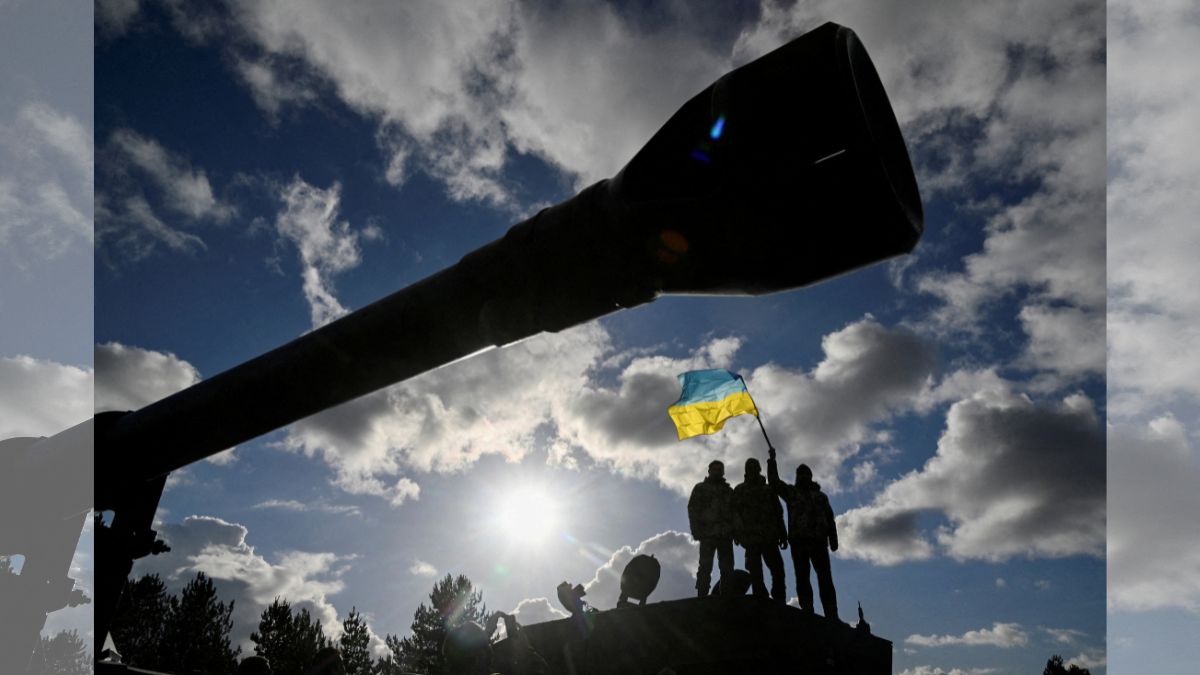British Challenger 2 tanks are playing a key role in Ukraine’s audacious cross-border raid into Russia’s Kursk Oblast, marking a significant escalation in the conflict. While their deployment showcases Ukraine’s growing military capabilities, the tanks’ operational challenges — ranging from mobility issues to logistical constraints — raise questions about their long-term effectiveness on the battlefield read more
)
Ukrainian personnel hold a Ukrainian flag as they stand on a Challenger 2 tank during training at Bovington Camp, near Wool in southwestern UK, February 22, 2023. File Image/Reuters
British Challenger 2 tanks have been used in Ukraine’s daring cross-border raid into Russia, with reports from British news outlets confirming their deployment on Russian soil for the first time.
A UK military source confirmed that these tanks were part of Kyiv’s offensive in the Kursk region, representing the largest foreign incursion on Russian soil since World War II. Kyiv’s 82nd Air Assault Brigade, equipped with these tanks, has been central to the operation.
The UK Ministry of Defence (MoD) has maintained that Ukraine has the right to use UK-supplied weapons in self-defence, even if that entails operations within Russia. However, the use of Storm Shadow missiles remains restricted to Ukrainian territory and Crimea.
Watch:
Footage released by Moscow’s defence ministry purportedly shows a Challenger 2 tank being struck by a Russian kamikaze drone near the Ukrainian-occupied town of Sudzha.
Western analysts, however, have questioned the authenticity of the heavily-edited footage, suggesting that the tank may not have been destroyed as claimed by Russian sources.
How old are UK’s Challenger 2 tanks?
The Challenger 2, designed and built by Vickers Defence Systems (now BAE Systems), has been a cornerstone of British armoured forces since its introduction in 1994. Developed as a replacement for the Challenger 1, it has seen action in several major conflicts, including Bosnia, Kosovo, and Iraq, where it gained a reputation for its durability and firepower.
Serving in four armoured regiments across the UK, each regiment operates 56 Challenger 2 tanks, emphasizing their importance in the British Army’s operational capabilities.
Despite its storied history, the Challenger 2’s unique design and specialized equipment have presented challenges in its deployment within the Ukrainian conflict, where it faces harsh terrain and logistical hurdles.
What challenges do the Challenger 2 tanks face?
The Challenger 2 tanks have been sparingly used by Ukrainian forces, largely due to their specific design and operational limitations. Britain donated 14 Challenger 2 tanks to Ukraine, but only a handful reportedly remain operational after one was destroyed during fighting around Robotyne in southern Ukraine last summer.
The tanks, which weigh 71 tonnes, are equipped with a 1,200-horsepower engine that has been criticised for being underpowered, leading to instances where the tanks have become bogged down in Ukraine’s soft soil.
A Ukrainian Challenger 2 crew member, speaking to UK’s The Sun, described the tank as a “sniper rifle among tanks” due to its accuracy. However, the tank’s rifled L30 120-millimeter cannon poses logistical challenges, as its ammunition is incompatible with other Western tank guns.
Also Read: Why are Ukrainian vehicles marked with white triangles?
The L30A1 cannon also wears out after 500 rounds, significantly less than the 1,500-round lifespan of smoothbore cannons on other Western tanks. This limitation has led the 82nd Brigade to use the tanks primarily as mobile howitzers, keeping them miles behind the front line to avoid the risk of them getting mired in combat zones, reported Forbes.
As of March 2024, Ukrainian media reported that only seven of the original 14 Challenger 2 tanks remain in combat-ready condition. The tanks frequently require repairs, particularly to turret parts and the aiming system, with delays in obtaining parts contributing to the low level of readiness.
What now?
The use of Challenger 2 tanks in Ukraine’s cross-border operations has raised concerns about a potential escalation of tensions between Russia and the West. The deployment of these tanks is seen as part of a broader strategy by Kyiv to reinforce success on the battlefield, as noted by Hamish de Bretton-Gordon, a former British tank commander.
He told The Telegraph, “It’s a ‘mark’ piece of kit and has a psychological hold over the Russians. The demonstration of combined arms maneuver is the first time in this war and very impressive. It must have taken months of training in secret, which is amazing on this ‘transparent’ battlefield.”
Despite their symbolic and tactical significance, the Challenger 2 tanks face operational challenges that limit their effectiveness. The lack of mobility, inadequate protection in some areas, and the unique logistics required for their maintenance and ammunition supply make them a double-edged sword in the Ukrainian arsenal.
With inputs from agencies

 1 month ago
25
1 month ago
25
)
)
)
)
)
)
)
)
)
)
)
)
)
)
)
)
)
)
)
)
)
)
)
)
)
 English (US) ·
English (US) ·